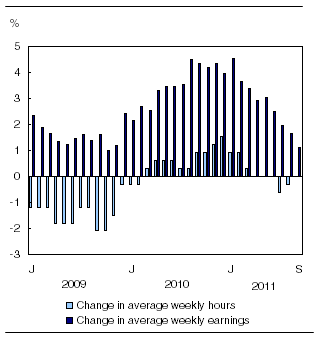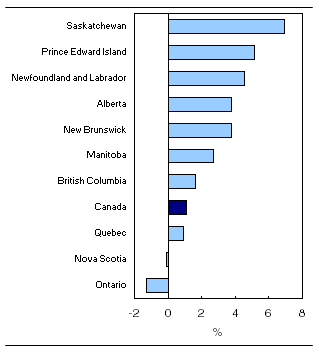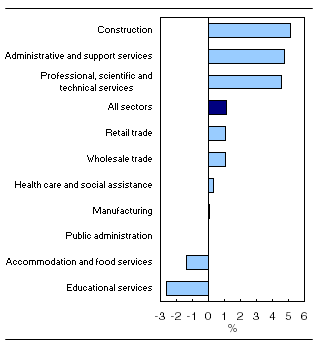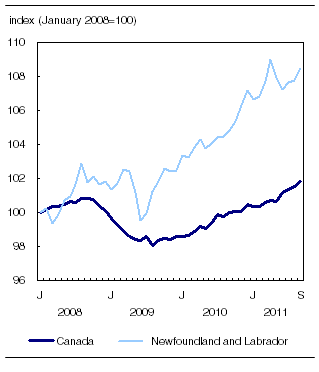Payroll employment, earnings and hours
Archived Content
Information identified as archived is provided for reference, research or recordkeeping purposes. It is not subject to the Government of Canada Web Standards and has not been altered or updated since it was archived. Please "contact us" to request a format other than those available.
Related subjects
-
[an error occurred while processing this directive]
Average weekly earnings of non-farm payroll employees declined 0.3% to $872.75 in September, partly offsetting an increase in August. Earnings have been relatively flat since the start of the year. On a year-over-year basis, average weekly earnings rose 1.1%, the smallest increase since November 2009.
Year-over-year change in average weekly hours and earnings

Chart description: Year-to-year change in average weekly hours and average weekly earnings
The 1.1% year-over-year increase reflects a number of factors, such as wage growth and changes in the composition of employment by industry, by occupation and by level of job experience.
Note to readers
The Survey of Employment, Payrolls and Hours (SEPH) is a business census of non-farm payroll employees. Its key objective is to provide a monthly portrait of the level of earnings, the number of jobs and hours worked by detailed industry at the national, provincial and territorial level.
Statistics Canada also produces employment data from its monthly Labour Force Survey (LFS). The LFS is a household survey whose main objective is to divide the working-age population into three mutually exclusive groups: the employed (including the self-employed), unemployed and not in the labour force. This survey is the official source for the unemployment rate and collects data on the socio-demographic characteristics of all those in the labour market.
As a result of conceptual and methodological differences, estimates of changes from SEPH and LFS do differ from time to time. However, the trends in the data are quite similar.
Unless otherwise stated, this release presents seasonally adjusted data, which facilitates comparisons by removing the effects of seasonal variations.
Non-farm payroll employment data are for all hourly and salaried employees, as well as "other employees" category, which includes piece-rate and commission-only employees.
Average weekly hours data are for hourly and salaried employees only and exclude businesses which could not be classified to a North American Industrial Classification System code.
All earnings data include overtime pay and exclude businesses which could not be classified to a North American Industrial Classification System code.
Average weekly earnings are derived by dividing total weekly earnings by the number of employees.
Data on the education sector
Changes in payroll employment in education during the summer months can be affected by changes in payment schedules and school-year calendars. Month-to-month changes should therefore be interpreted with caution, and more attention given to long-term trends.
Average hours worked per week can also influence growth in year-over-year earnings. However, the average work week was unchanged in the 12 months to September at 33.0 hours. Average weekly hours increased 0.3% from August to September.
Average weekly earnings up in most provinces
In the 12 months to September, average weekly earnings rose in every province except Ontario and Nova Scotia. The largest increases occurred in Saskatchewan, Prince Edward Island and Newfoundland and Labrador.
Average weekly earnings in Saskatchewan reached $906.22 in September, up 6.9% from the same month a year earlier. In Prince Edward Island, earnings increased 5.1% over the same period to $745.81 but remained the lowest among the provinces.
On a year-over-year basis, average weekly earnings in Newfoundland and Labrador increased 4.6% to $884.66. Earnings in this province have grown at a higher rate than the national average since December 2010 (see the "Provincial profile" section of this release).
In Ontario, year-over-year earnings declined 1.3% from $901.16 to $889.13. Declines were spread across several service industries, most notably in finance and insurance; educational services; wholesale trade; health care and social assistance as well as public administration.
Year-over-year change in average weekly earnings by province, September 2010 to September 2011

Average weekly earnings by sector
Year-over-year growth in average weekly earnings exceeded the national average of 1.1% in three of Canada's largest industrial sectors: construction; administrative and support services; and professional, scientific and technical services. At the same time, earnings declined in educational services as well as in accommodation and food services.
In construction, average weekly earnings rose 5.2% to $1,117.40. The largest increases were in heavy and civil engineering construction; construction of buildings and specialty trade contractors.
Year-over-year change in average weekly earnings in the 10 largest sectors, September 2010 to September 2011

Non-farm payroll employment by sector
Non-farm payroll employment increased by 47,900 from August to September. On a year-over-year basis, payroll employment increased by 273,100 (+1.8%).
Payroll employment was up in both goods and service industries. The bulk of the increases occurred in manufacturing; construction; retail trade; and accommodation and food services.
In the 12 months to September, the rate of growth in the number of employees was most notable in mining, quarrying, oil and gas extraction; utilities; construction; professional, scientific and technical services; accommodation and food services; health care and social assistance as well as transportation and warehousing.
Provincial profile: Newfoundland and Labrador
From time to time, this release profiles an industrial sector or a province with a notable trend in employment, earnings or hours. This month, the focus is on Newfoundland and Labrador. While this province has an unemployment rate that is higher than the national average, it has seen higher-than-average growth in employment and earnings over the past two years.
In September, non-farm payroll employment totalled 206,300 in Newfoundland and Labrador, 1.4% of the national total. Between September 2010 and September 2011, payroll employment increased 3.5% (+6,900), one of the fastest growth rates of any province and nearly double the national rate of 1.8%.
During the economic downturn of 2008 and 2009, non-farm payroll employment within Newfoundland and Labrador declined at a slower pace than the national average. Between August 2008 and August 2009, payroll employment in the province fell 1.6% compared with a 2.7% decline nationally.
From August 2009 to September 2011, payroll employment levels in Newfoundland and Labrador more than recovered, increasing by 7.1% compared with the national average of 3.8%. The province's employment levels have been on an upward trend since June 2009.
Non-farm payroll employment in Newfoundland and Labrador, January 2008 to September 2011

In the 12 months to September, payroll job gains in Newfoundland and Labrador were widespread across goods and services industries. The largest gains were in construction and professional, scientific and technical services.
Average weekly earnings in Newfoundland and Labrador increased 4.6% to $884.66 in the 12 months to September. This was one of the largest growth rates provincially and over four times the national average of 1.1%.
Over this period, the increase in earnings among the larger sectors was above the provincial average in administrative and support services; educational services; and retail trade.
Compared with the national average, Newfoundland and Labrador has a higher share of employees working in educational services, health care and social assistance and public administration. These sectors, which are generally higher paying, are a factor in Newfoundland and Labrador's high average wages.
Employees in Newfoundland and Labrador also worked more hours than employees in other provinces, except Alberta. Average weekly hours worked in Newfoundland and Labrador totalled 33.8 hours in September, compared with the national average of 33.0 hours.
In the goods sector, employees worked an average of 39.2 hours per week in September, compared with the national average of 38.8 hours. In the services sector, average hours totalled 32.9 hours, compared with 31.8 hours nationally.
In the 12 months to September, average weekly hours declined 0.6% in Newfoundland and Labrador from 34.0 hours to 33.8 hours. While average weekly hours were at or above 34.0 hours for most of 2010 and early 2011, they have remained below 34.0 hours since May 2011.
Available on CANSIM: tables 281-0023 to 281-0039 and 281-0041 to 281-0049.
Definitions, data sources and methods: survey number 2612.
A data table is available from the Key resource module of our website under Summary tables.
Detailed industry data, data by size of enterprise based on employment, and other labour market indicators will be available soon in the monthly publication Employment, Earnings and Hours (72-002-X, free).
Data on payroll employment, earnings and hours for October will be released on December 22.
For more information, contact Statistics Canada's National Contact Centre (613-951-8116; toll-free 1-800-263-1136; infostats@statcan.gc.ca), Communications Division.
To enquire about the concepts, methods or data quality of this release, contact Jeannine Usalcas (613-951-4720), Labour Statistics Division.
- Date modified:
